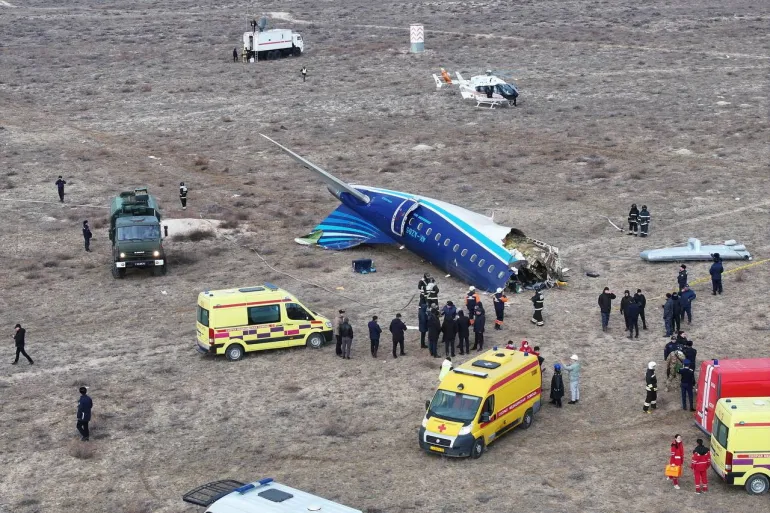Azerbaijan Airlines Flight with 67 People Crashes Near Aktau, Kazakhstan; Plane Engulfed in Flames

A passenger plane from Azerbaijan Airlines, an Embraer 190 with registration number 4K-AZ65, crashed near Aktau city in Kazakhstan after encountering severe technical difficulties. The plane, operating as flight J2-8243, was en route from Baku, Azerbaijan, to Grozny, Russia, but was rerouted to Aktau due to fog at its original destination.
The crash occurred near Aktau airport, approximately 3 kilometers away. According to Kazakhstan’s Emergencies Ministry, 62 passengers and 5 crew members were onboard. Preliminary reports state 28 survivors, with 22 hospitalized. Passengers included 37 Azerbaijanis, 6 Kazakhs, 3 Kyrgyz citizens, and 16 Russians.
The aircraft reportedly experienced a collision with a flock of birds, causing a steering malfunction. Despite the pilots’ efforts to gain altitude and speed, the controls failed completely. Before the crash, the plane circled the airport multiple times, attempting an emergency landing. It ultimately stalled and descended rapidly.
FlightRadar24 data confirmed that the aircraft transmitted a distress signal before crashing at 6:28 am UTC (11:58 am local time). The platform also reported strong GPS jamming affecting the plane’s ADS-B data.
Visuals from the site showed ambulances, rescue operations, and passengers being evacuated through the emergency exit at the aircraft’s rear. Azerbaijan Airlines announced that further details about the incident would be shared with the public.
Here’s a detailed account of the incident:
A devastating plane crash involving an Azerbaijan Airlines Embraer 190 aircraft shocked the aviation community and the regions involved. The aircraft, registered as 4K-AZ65, was operating flight J2-8243 from Baku, Azerbaijan, to Grozny, Chechnya. Weather conditions, specifically dense fog at Grozny Airport, necessitated a diversion to Aktau, Kazakhstan. Tragically, the journey ended in disaster near Aktau Airport.
According to initial reports, the plane carried 62 passengers and 5 crew members. Among the passengers were 37 Azerbaijani nationals, 6 Kazakh citizens, 3 Kyrgyz citizens, and 16 Russian nationals. Following the crash, Kazakhstan’s Emergencies Ministry confirmed 28 survivors, 22 of whom were hospitalized with varying degrees of injuries.
Sequence of Events Leading to the Crash
The aircraft encountered severe technical difficulties after entering Kazakh airspace. A distress signal was transmitted, indicating a critical situation. Reports suggest the plane collided with a flock of birds, which caused a steering malfunction. Despite the pilots’ best efforts to stabilize the aircraft by gaining altitude and speed, the controls failed entirely. As the pilots struggled to maintain control, the aircraft began circling near Aktau Airport, desperately attempting to prepare for an emergency landing.
Eyewitness accounts and data from FlightRadar24 revealed the dramatic moments leading up to the crash. The plane was observed ascending rapidly before stalling multiple times. Videos circulating online show the aircraft making erratic maneuvers as the pilots fought to regain control. The aircraft ultimately crashed around 6:28 am UTC (11:58 am local time), just 3 kilometers from Aktau Airport, near the shore of the Caspian Sea.
Complicating Factors
The flight’s challenges were compounded by external factors such as reported strong GPS jamming in the area, which affected the aircraft’s Automatic Dependent Surveillance–Broadcast (ADS-B) system. FlightRadar24 noted that the jamming led to the transmission of inaccurate data, adding another layer of difficulty to an already critical situation.
Rescue Operations and Survivors
Following the crash, rescue teams quickly arrived at the scene. Visuals from the site depicted ambulances and emergency personnel working tirelessly to extract survivors from the wreckage. Some passengers were seen deboarding through the emergency exit at the aircraft’s rear. The swift response helped ensure that survivors received immediate medical attention.
Medical teams at nearby hospitals are treating the injured, with reports indicating that several are in critical condition. The survivors’ stories will likely provide critical insights into the moments leading up to the crash.
Investigations Underway
Authorities in Kazakhstan and Azerbaijan have launched thorough investigations into the incident. Aviation experts are examining the causes of the crash, with particular focus on the bird strike, steering malfunction, and the reported GPS interference. The involvement of multiple countries, given the diverse nationalities of passengers, ensures a comprehensive and collaborative investigation.
Broader Implications
The crash underscores the challenges posed by bird strikes and electronic interference in modern aviation. It also highlights the importance of advanced safety protocols and pilot training in emergency scenarios. This tragedy will likely prompt aviation authorities worldwide to review existing procedures and consider new measures to mitigate similar risks.
As investigations continue, the focus remains on supporting the survivors and families affected by this heartbreaking accident. Azerbaijan Airlines has expressed its commitment to transparency, pledging to keep the public informed as more details emerge. The international aviation community mourns the loss of lives and extends solidarity to all those impacted by this tragedy.


